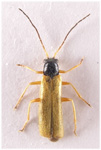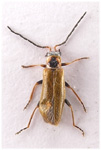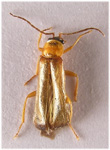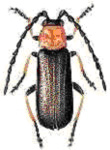Our only member of the Silinae is Silis ruficollis (Fab.), a rare insect from southern England and Wales. It is a distinctive species; 6-7mm., black with pronotum, base of tibiae and mandibles red. The pronotum is deeply notched at the hind angles and coarsely punctate throughout. Each elytron has three slightly raised lines.
Members of Cantharinae have long elytra that cover, or very nearly cover, the wings and abdomen. Podabrus is featured. Ancistronycha abdominalis (Fab.) is a local northern english and welsh species, its metallic black or blue elytra are distinctive. It differs from Cantharis and Rhagonycha in having all claws entire and appendiculate. Cantharis (15 spp.) and Rhagonycha (7 spp.) complete the Cantharinae. In Cantharis the anterior claw of each pair is toothed and the third tarsal segment on the mid and hind legs is bilobed. In Rhagonycha the third tarsal segment is simple and the claws are divided longitudinally from the apex.
Malthininae includes Malthinus (4 spp.), all of which have toothed mandibles, and Malthodes (12 spp.), with simple mandibles. All species have short elytra partly exposing both the wings and abdomen. They are all small insects.
Included in Michael Fitton's work are the most recent keys in english to the British species. Joy's keys contain errors and some characters are not satisfactory. Dahlgren, G. and Wittmer, W. cover the family in Vol. 6 (1979) of Die Kafer Mitteleuropas, edited by Freud and updated in Vol. 13 (1992) by Lohse and Lucht. As well as giving an idea on the distribution of each species, Alexander presents much interesting ecological information on each species in his 2003 atlas.
Common from late spring onwards the soldier/sailor beetles are soon recognised in the field, adults are short lived and there is a succession of species through to september when Rhagonycha fulva (Scopoli) may be seen in great numbers across England and Wales. Found by sweeping long grass and low vegetation or beating shrubs, woodland clearings and margins seem most productive in species. Flowers of all kinds should be examined. Some have particular requirements e.g. Rhagonycha testacea (Linnaeus) prefers wet woodland and marshes while others e.g. Rhagonycha limbata (Thomson) prefer dry pastures or are arboreal e.g. Rhagonycha lignosa (Muller). The lowland Cantharis pallida Goeze prefers open marshy vegetation. All species are believed to be carnivores or omnivores, larvae mostly in the ground or among moss.

Cantharis
cryptica

Cantharis
cryptica

Cantharis
decipiens

Cantharis
decipiens

Cantharis
decipiens

Cantharis
lateralis

Cantharis
lateralis

Cantharis
lateralis

Cantharis
lateralis

Cantharis
lateralis
Cantharis
livida

Cantharis
livida

Cantharis
nigra

Cantharis
nigra

Cantharis
nigra

Cantharis
nigra

Cantharis
nigricans

Cantharis
pallida

Cantharis
pallida

Cantharis
pallida

Cantharis
pellucida

Cantharis
pellucida

Cantharis
rufa

Cantharis
rustica

Cantharis
rustica

Cantharis
rustica
Cantharis
rustica

Cantharis
rustica

Cantharis
thoracica
Cantharis
thoracica

Podabrus
alpinus

Podabrus
alpinus

Rhagonycha
elongata

Rhagonycha
fulva

Rhagonycha
fulva

Rhagonycha
fulva

Rhagonycha
lignosa

Rhagonycha
lignosa

Rhagonycha
limbata

Rhagonycha
limbata

Rhagonycha
lutea

Rhagonycha
testacea

Rhagonycha
translucida

Silis

Malthinus
balteatus

Malthinus
balteatus

Malthinus
balteatus

Malthinus
flaveolus

Malthinus
seriepunctatus

Malthinus
seriepunctatus

Malthinus
seriepunctatus

Malthodes
marginatus

Malthodes
minimus

Malthodes
minimus
Home